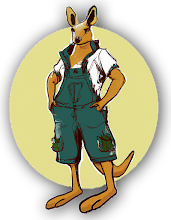Creating my own rubric for the newsletter assignment in this course was a great exercise. We didn't only have the opportunity to critically analyze the essential elements of design that must be included in the newsletter. We also had the opportunity to learn what is involved in creating a grading rubric that holds students to a standard of quality and is easy to understand (Rubistar, 2008).
I thoroughly dislike Second Life. I always thought of myself as a very adaptable person, and in my various careers, I have used various degrees of detailed simulation programs for different purposes. This "game" is by far the most completely outlandish and ridiculous thing I've ever experienced. It must be called second life because it can consume your entire life just figuring out how to make the thing run. However, by looking at the "game" from a teaching perspective, if I were teaching a course solely on animation or virtual reality, or needed to have a platform that allowed virtual interaction, I would definitely use this program with my students from day one (Wong, 2006).
The discussion posts regarding perceptions of beauty provided a great opportunity for reflection. I believe our current cultural concept of beauty is actually not the averaging, but more so an extreme version of the way a thing or person can look. I believe proportions are decided according to where the attention is desired to go. The exercises during this week were a great exercise in determining personal tastes with regard to beauty and proportion, and explaining the reason for those preferences.
I thoroughly did not enjoy the historical portion of the first week in 5366. I felt it was the antithesis of everything we learned in the first course. If I was a high school student who signed up for a graphic design elective presented with such a low-tech, and seemingly irrelevant dive into history, I probably would have dropped the class in favor of something else. That being said, this is a master's level class, not high school graphic design. I suppose that knowledge of where we've been is essential to then gain knowledge of where we're going.
Learning about the CRAP acronym (Contrast, Repetition, Alignment, Proximity) was perhaps the most beneficial part of this entire class (Yearwood, 2009). I majored in journalism in college, and perhaps in my undergraduate design classes, the professor talked about these elements, but I don't remember. I really enjoyed the demo portions of the week and learning the elements of design...better presentation in one week of on-line lectures and examples than in three years of classes in undergrad. When I learned this was the next class in the program, I was so excited. And the demo lectures did NOT disappoint. I can't wait to put these lessons into use.
Logo design was thought-provoking. Classrooms can carry such a negative connotation of being stale, boring and irrelevant and branding could be a huge leap forward in creating a different mind-set in students. As a teacher, I could work to develop a brand that tells students that my class will be tough, thought-provoking, and rewarding...while also telling them that I stand for ethical behavior and high expectations. I used the Smithsonian logo as an example of one that conjures up feelings of the importance of history. Kids may fight tooth and nail to avoid going into a classroom, but they'll line up to go to the Smithsonian (Smithsonian, n.d.).
Just coming up with a personal teaching mission statement for me is hard because (1) I'm not currently a teacher and (2) I've always been taught to use my next higher administration mission statement to craft my own. I hadn't thought before about establishing a personal mission statement for my classroom, however it makes sense. The mission statement serves as a guide to help the teacher stay focused on what he hopes to accomplish in the classroom, as well as to reflect upon the teaching he has done (Chism, n.d.).
Future learning experiences will include determining how to most effectively craft a mission statment and perhaps even how to include the students in the process.
Chism, N. (n.d.) Developing a Philosophy of Teaching Statement. http://spinner.cofc.edu/~cetl/Essays/DevelopingaPhilosophyofTeaching.html?referrer=webcluster&
Tips for Visiting with Children (n.d.) Smithsonian: Visitor Information for Kids & Families. http://www.si.edu/visit/kids_and_families.htm
What is a Rubric (2008). Rubistar: ALTEC at University of Kansas. http://rubistar.4teachers.org/index.php?screen=WhatIs&module=Rubistar
Wong, G. (November 13, 2006). Educators explore 'Second Life' online. http://articles.cnn.com/2006-11-13/tech/second.life.university_1_second-life-educators-virtual-world?_s=PM:TECH
Yearwood, J. (2009). Basic Elements of Page Design. [multimedia]
Subscribe to:
Post Comments (Atom)




No comments:
Post a Comment